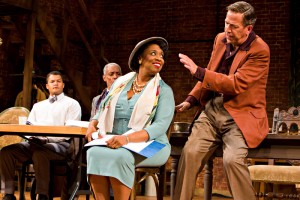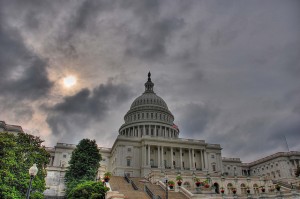Class differences loom larger than racial ones when it comes to dating, tweets Ronnie Streff. Do you agree or disagree?
Black Mom, White Sons
A disproportionate number of black children are available for adoption, and most transracial adoptions involve white parents and black children. TheGrio reports on one Georgia family who has confronted stereotypes and myths around race and adoption.
How to Save the Lincoln Theatre
The historic Lincoln Theatre, the “jewel of Black Broadway,” is running out of money and could close by year’s end. Should the D.C. government infuse more public money to save it, or not? The Washington City Paper‘s Ally Schweitzer rejects both approaches, writing that “public money alone can’t solve the problem. But new management and a strong public relations strategy could help.”
Life for Interracial Couples in D.C.
Last week, we wrote about the rise of interracial marriage and asked how tolerant D.C. is of mixed-race couples. Many of you responded that you sometimes receive stares or negative comments, while others wrote their experiences have been mostly positive.
Admittedly, these stories can’t fully capture every experience, but they do provide some insights into what life is like for interracial couples in D.C. If you’d like to share your story, contribute by posting a comment below.
Luis writes that “the more interracial couples feel comfortable out in the world, the better chances we have of building a world defined by our common humanity rather than our race:”
When I mentioned this article to my wife, she asked if I was going to comment on it. “Wait, we’re interracial, right?” she had to double-check. We often forget. When it comes to our relationship I don’t really see race. We haven’t been in DC that long, but most places we’ve been, we are pretty comfortable in public…
“Behind the Name: Adams Morgan”
Adams Morgan was named after two 1950s schools: John Quincy Adams Elementary, for white students, and Thomas P. Morgan Elementary, for black students.
(Photo) New U Street Mural References March for Jobs
A new U Street mural includes March for Jobs imagery. The idea to protest en masse for job equality has been resurrected most recently on the eve of the Martin Luther King, Jr. Memorial dedication.
Is Gentrification Always Bad?
Gentrification is not only good for communities, but necessary for cities to thrive, Kaid Benfield argues in a post on The Atlantic Cities. But, as he cautions, steps need to be taken to ensure income diversity. “The challenge” with gentrification, Benfield writes, “is to have enough without having too much.”
DCentric Picks: ‘Trouble in Mind’ and Food Day

Richard Anderson / Courtesy of Arena Stage
Brandon J. Dirden as John Nevins, Thomas Jefferson Byrd as Sheldon Forrester, E. Faye Butler as Wiletta Mayer and Marty Lodge as Al Manners in "Trouble in Mind."
What: “Trouble in Mind,” a play about a 1955 racially integrated theater company that wants to present a race play.
Where: Arena Stage, 1101 6th St. SW.
When: The play runs through Sunday.
Cost: Prices vary depending on seats and showtimes. You can find ticket prices here.
Why you should go: The play-within-a-play, set more than 50 years ago, still has relevance today. The black characters are seen confronting racial stereotypes as they work to make it to Broadway. A black and white cast is shown producing a play about a young, southern black man who becomes the target of a lynch mob.
Other events to consider: Monday is Food Day, which seeks to promote healthy, affordable and sustainable food. D.C. is home to a number of events, including the Food Day Extravaganza on Woodrow Wilson Plaza. There will be chef demonstrations, entertainment, educational activities and, yes, free food. The event starts at 11 a.m.
Two Americas Coexist in D.C.
D.C. is a microcosm of national class disparities, and the country saw the gulf between the rich and poor widen during the recession. Theo Balcomb, production assistant for “All Things Considered,” writes about these “two Americas” she saw while helping produce stories on the economy.
While in Spartanburg, S.C., Balcomb met a diabetic pregnant woman on disability, “struggling to sort through cereal and pork patties in her food pantry box.” Balcolm witnessed the other America when reporting from New York’s Upper East Side, where, while visiting a seven-story mansion, her “biggest concern was not getting winded as I carried a bottle of wine, a corkscrew and a cheese plate up to the roof.”
And that’s what’s confusing: That America is a place where these two worlds can coexist, often without knowledge of each other. One where a pregnant woman has to wait in line for frozen pork patties, and one where I’m in New York being offered goat cheese and fig spread and crisp gluten-free crackers and low-fat string cheese.
The contrast has always been there, but it’s looking stark right about now. The 27-year-old woman working in the grocery store lit up when she had this thought: Those people in Washington, those people with all the money who make all the decisions, they should have to live a week in our shoes. It could be a new reality show, she said brightly. Just a week. Just a week in our shoes.
Many around the country view D.C. as the power capital of the world, but the District’s disparities are some of the starkest. The D.C. region has the highest incomes and lowest poverty rates in the nation. But 1 in 5 people in the District proper live below the poverty line. In Ward 3, 49 percent of people have incomes higher than $100,000 annually and unemployment is about 3 percent. A few miles away in Ward 8, 41.1 percent of people have incomes below $25,000 and unemployment is at about 25 percent.
Those “people in Washington… with all the money who make all the decisions” are presumably politicians and lobbyists on Capitol Hill. They don’t need to travel to South Carolina to see poverty or hardship. They can drive 10 minutes away to see it.
Should D.C. Save Lincoln Theatre?
There are plenty of voices calling for the city to prevent the closure of U Street’s Lincoln Theatre, the “jewel of Black Broadway.” Here’s one that isn’t. Eli Lehrer writes that the revitalization of U Street, which included the Lincoln Theatre restoration, hurt the area’s ability to remain a cultural destination. U Street “may have more jazz history per square inch than any other similar stretch in the world,” Lehrer writes, but now only two jazz clubs remain.










